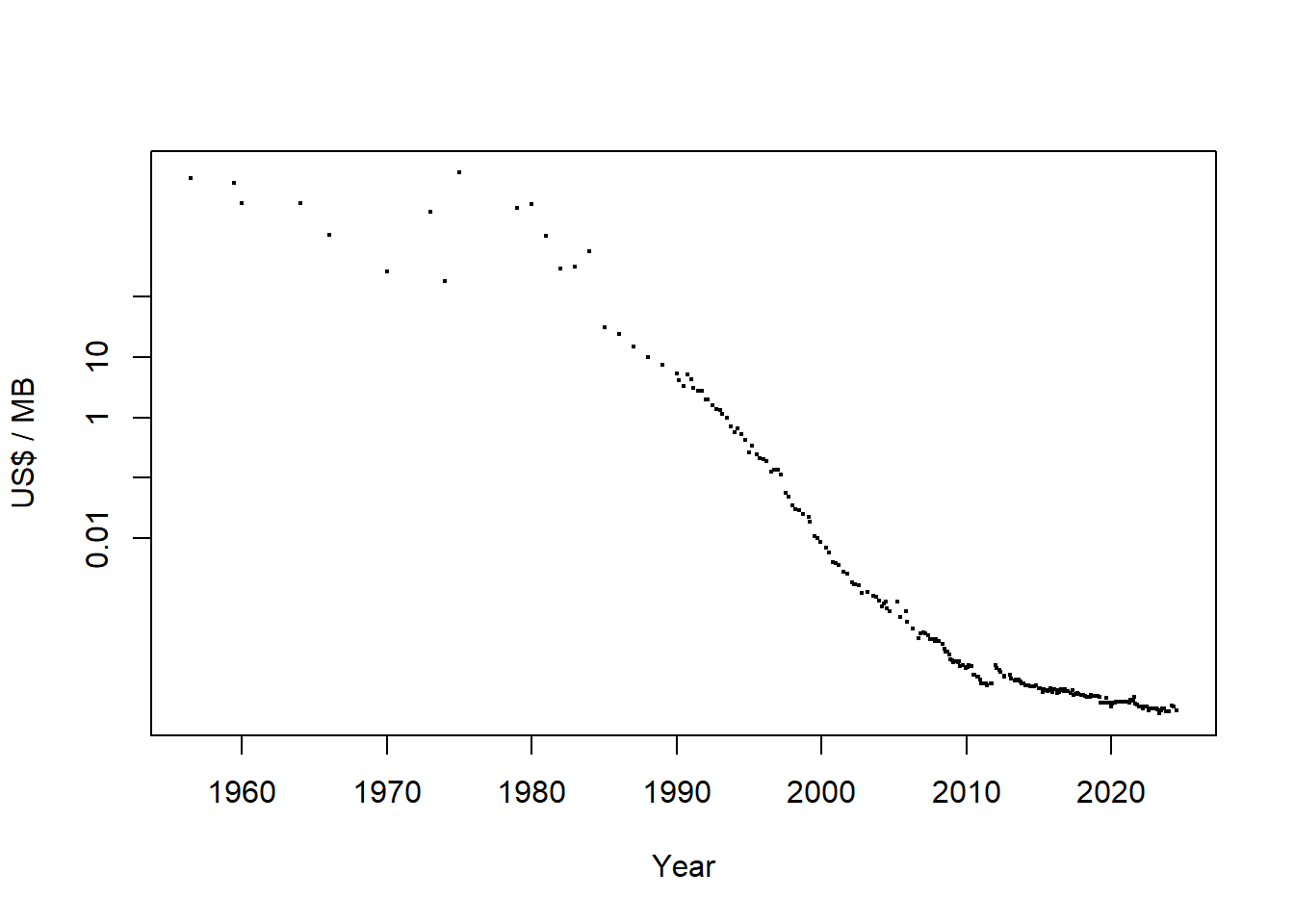Chapter 1 Biodiversity Technologies
1.1 What are Biodiversity Technologies?
Biodiversity technologies are tools that allow researchers and others to study, monitor and conserve biodiversity. These tools can be used to monitor a wide range of species, habitats, and ecosystems, potentially in (near) real-time and/or from a great distance away.
1.1.1 What has enabled Biodiversity Technologies?
The development of biodiversity technologies has been enabled by the rapid advances in sensor technology, data processing, and communication networks. These technologies have made it possible to collect, store, and analyse large amounts of data from a wide range of sources, including remote sensors, cameras, and acoustic recorders.
This has been accompanied by a decline in the cost of these technologies (e.g. Figure 1.1), making them more accessible to researchers, conservationists, and others interested in monitoring biodiversity.
## Warning in xy.coords(x, y, xlabel, ylabel, log): NAs introduced by coercion
Figure 1.1: The decline in storage costs per megabyte in consumer hard drives.
These technologies can potentially create vast datasets, and in order to adhere to the FAIR principles (Findable, Accessible, Interoperable, Reusable), it is important for the data to be accompanied by an appropriate suite of data standards, such as those developed by TDWG.
1.2 Overall Philosophy
1.2.1 Leverage what already exists
Many of the tools that are needed to monitor biodiversity already exist, and the goal of WildlifeSystems is to bring these tools together in a coherent and integrated way. This will allow researchers and others to build on existing technologies to develop new tools and applications that can be used to monitor biodiversity in a wide range of environments.These tools are designed to be flexible, scalable, and easy to use, and to provide a platform for the development of new technologies and applications.
1.2.2 Innovate where necessary
“Technology is stuff that doesn’t work yet.”Where suitable technological solutions already exist, use them. Limit technological research to what needs to be new. Most of the time it’s OK to use existing technology, and focus development on the biodiversity related problem you’re trying to solve. Older technologies are often better understood and more stable. Some of the technologies WildlifeSystems leverages to innovate in the biodiversity sphere are given in Table 1.1.
| Technology | Year Introduced | Age in 2025 |
|---|---|---|
| Ethernet | 1973 | 52 |
| BASH | 1989 | 36 |
| Linux | 1991 | 34 |
1.2.3 Plan for heterogeneity
Any network of devices will become heterogeneous given sufficient time. The primary driver of this shift to heterogeneity is continuous technological innovation combined with obsolescence of technical components.
Secondary drivers are changes in the purpose, capabilities, and/or scale of the network over time.
The WildlifeSystems ecosystem is designed to be able to handle this heterogeneity, and to allow for the easy integration of new technologies as they become available.
1.2.4 Modularise
The WildlifeSystems ecosystem is designed to be modular, with each component able to be used independently or in combination with other components. This allows users to build custom solutions that meet their specific needs, and to easily add or remove components as required.
Defined interfaces between components allow for easy integration of new technologies, and for components to be replaced or upgraded without affecting the rest of the system. This also lets contributors to focus on what they are best at.